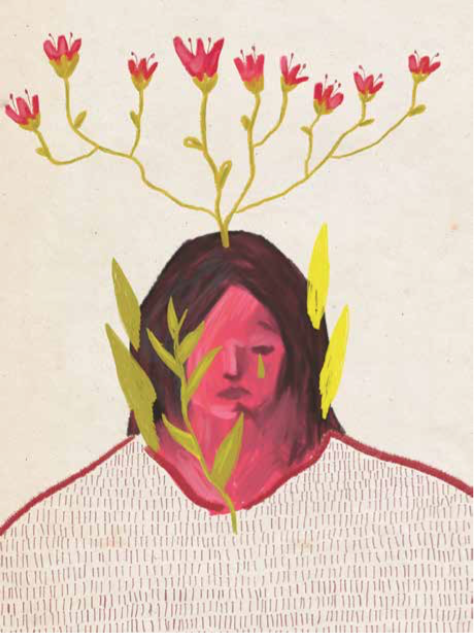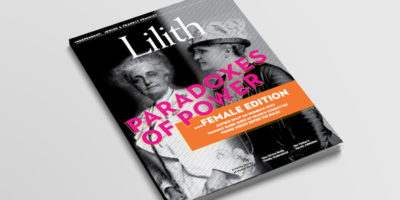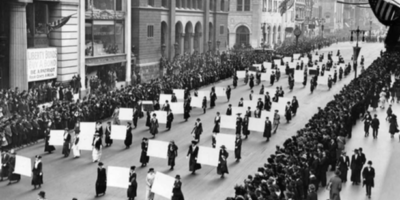
Illustration by Sofi Naydenova
A Place at the Table
A Story of Intermarriage, Miscarriage & Matzoh
The Passover invitations had already gone out when we lost the baby. Every year, since before we were married—and Bill did it long before I came along—we’ve hosted a seder for our friends, mostly half-and-half couples like us. It’s always on the second night, in deference to our guests’ family traditions. In the old days we would drink insane amounts of wine, and try to be funny when Bill called on us to read—Zach was always the simple son, Nathaniel with his dyslexia always got the parts with the hard-to-pronounce names. Emma always added “or she” to her parts, and Samantha could be relied upon to stroke the massive horseradish root and purr like Liz Taylor in Cat on a Hot Tin Roof. The choruses were raucous, and ended in laughter. Time went on, and the circle expanded. Boyfriends and girlfriends became husbands and wives. Playpens and bouncy seats appeared around the table. People started leaving earlier, leaving more bottles unopened. Watching Bill lead the seder was one of the things that made me fall in love with him. He was not raised in a religious household, does not attend synagogue. The tradition for him is personal, it is principled. He would never use kumbaya words like “celebrate,” “community” and “cherish,” but he felt a strong urge to bring together the people close to him and continue a tradition in which he saw beauty, and history, and worth. He led the seder with love, with just enough irreverence that it was fun, with a seriousness that made us all feel privileged to take part.
Bill’s grandfather Sidney was a rabbi, a leading figure in the Reform movement of the 1960s. We’ve got Time-Life books on the shelf that show him marching for peace, and he’s important enough to have his name in the caption. But he was a stern man, Bill says, and maybe that’s why Bill’s father rebelled, raising Bill without any religion, other than what he got at Sidney’s table. After Sidney died, Bill’s aunt hosted a seder for a few years, but then she moved away. Bill was in law school when he inherited the stack of slender hardcover haggadahs, their dignified grey cloth covers and stately language showing their age more and more each year. In the early days, we always had a spare to put at the empty place we set for Elijah. Now we have to share.
Bill and I were married by a justice of the peace under a tent in a big open field that we’d chosen for its majestic view out across the Hudson River. Afterwards, one septuagenarian friend of the family wonderingly called it “the shortest service I’ve ever seen.” My devoutly Catholic relatives and his extended Jewish family were, we figured, equally offended. But neither of us practiced a religion, neither of us wanted an empty show. What we wanted was to be married, to have a home, a future, a family, and for that we didn’t need a communion wafer or a huppah. For that we needed our friends, our family, a great band that played serious Motown, and a big tent to keep out the pouring rain. (Turns out we didn’t need the view, either.)
After we were married, the seder felt different to me. I had always helped— cooking, polishing his grandparents’ silver, setting the table, and then, the next day, scraping sticky haroset off the floor and bleaching the wine stains out of the white table cloth. But it was his celebration. I was an onlooker. Only now it was my home too, and I was a host, not a guest. I didn’t expect to suddenly own the seder, the way under New York law I immediately half-owned the apartment where it took place. But I couldn’t help feeling hurt when we took our places at the table that year and, at the haggadah’s instruction that the “mistress” kindle the lights and recite the blessing, he turned as usual to my Jewish friend Andrea.
I told myself it didn’t matter; after all, I knew how Bill had felt growing up Jewish in a Christian society. Invisible, an outlier. The town where he grew up would stick a yellowing plastic menorah next to the giant crèche scene on the village green, in grudging compliance with a legal settlement. Even though there were non-Jews at our table, Passover would never be, for Bill, a “multicultural” event. I knew his seder was not just a tribute to his grandfather, an affirmation of his own history. It was a refutation of that feeling of not belonging. It was about his experience of being Jewish, saying out loud that being Jewish mattered. Who was I to insist on a place at the head of that table?
Andrea was flustered, but she obliged. The next year, she refused.
“The woman of the house should light the candles,” she said to Bill, in front of the assembled group. Everyone went silent, and Bill’s jaw muscles twitched. I felt nervous, and foolish. I was being pushed into a confrontation on terrain where I wasn’t entirely sure of my footing. My home, but not my bloodline. Which mattered more? Where was the line between respecting tradition and disrespecting a spouse? Yvette and Emma nodded firmly in agreement—maybe they’d discussed it beforehand—and Bill reddened.
“Come on, Bill,” said Zach quietly, and Andrea put the matches in my hand. “Say it with me, sweetie?” I asked. Of course I knew the prayer. He knew I knew it. His body lost some of its stiffness, and he finally nodded. I struck the match and the room exhaled.
Later, he apologized. We were both still learning our way around each other, finding ways in which we each clung to parts of our religious backgrounds. A wreath on the front door, it turned out, made him feel unwelcome in his own home, but a living room without a Christmas tree made me feel sad in a happy season. He loved our Easter egg hunts; I stopped working on Saturdays when I could. He gives out the Secret Santa assignments to my family at Christmas. I light the Passover candles.
We had been married for almost four years when our daughter Sarah was born. She was three months old at her first Passover, and I was just finishing nursing her when our guests started to arrive. I greeted them from my chair and went back to watching her nurse, so in love with that little face—I still couldn’t believe she was really here, our beautiful girl—and almost missed what Nathaniel was telling Bill.
“Chloe’s class did a unit on families,” he was saying. Chloe, the senior-most member of the junior generation, was in first grade. “The teacher asked the kids to write about a family tradition, and you’ll never guess what Chloe picked.” He pulled from his bag a multi-page booklet, stapled down the side and wrinkled by the careful attention of small hands. On the front was a brightly crayoned illustration of a table surrounded by stick people, entitled “Sater at Bill and Jen’s House.” We all exchanged surprised looks. Really? When did that happen? For us the gathering was fun, an annual get-together with a religious pretext—and text—that guaranteed we’d all sit around the same table at least once a year. It had deep personal meaning for Bill, and had become special to each of us in our own way, taking from it what was important to us. Community, continuity, comfort, cabernet. But I don’t think it had occurred to any of us that we were creating something bigger, something we were passing on, year after year.
I could see the joy in Bill’s face, in his voice, as he led the service that night. He was doing it for our daughter now, had found renewed meaning in this most special of nights. Sarah, named for Sidney, our little miracle. We knew our odds were long—periodic surgeries to treat uterine fibroids, ovarian cysts and endometriosis had left my reproductive When it instructed that the “mistress” kindle the lights and recite the blessing, he turned as usual to my Jewish friend Andrea. Subscribe at organs badly scarred, hardly a welcoming haven for a baby. My longtime Ob/ Gyn had told me in my twenties that I wouldn’t withstand contractions, I’d need to go Caesarian if I were ever to take a baby to term. And, she added, in that direct, matter-of-fact way Dr. Silver had of giving me bad news—I had come to recognize that tone—I shouldn’t count on it.
It took us three years to conceive Sarah. Perhaps we shouldn’t have tempted fate by trying again.
I love the four questions at the center of the seder service. Curiosity and skepticism welcome here, it says. All will be explained. Growing up Catholic, I had a lot of questions. There were the obvious ones: how does a virgin give birth, how could anybody be infallible. And some things seemed patently unfair, like my inability to become a priest. Every Sunday I was asked to believe that, before my eyes, a little round wafer was transformed into the literal body of a man who had been dead for millennia. And then I was supposed to eat it.
“Faith,” our priest once explained, “sometimes means believing in things you cannot understand.” I liked the ritual, the shared hope, the sense of community I found in church. But I was a child, a natural scientist. I wanted to make sense of my world. I couldn’t square my need for facts with the demands of faith. Eventually, facts won.
At the moment of my second child’s conception, miraculous disaster struck. I know exactly where, on which chromosomes, things went wrong, all the different ways in which this particular little ball of cells never should have made the leap toward the book of life. Somehow the microscopic typos in its quickly replicating dna escaped nature’s proofreaders—for a time. More than a cleft palate, more than a sleepy eye, a club foot. The center would not hold. But for 18 weeks I didn’t know that—I was in perfect bliss. Sarah would have a sibling, and together they would raise their tiny fingers and stick them in the eye of statistics. It didn’t matter that I was close to 40, that my insides were a mess. We would have a family of four, just right, nuclear symmetry. Bill and I would give them love and joy and hope and all the things children need to make their way in the world.
By 12 weeks I’d started wearing maternity clothes, my body having quickly forgotten all my post-partum sit-ups and regained its seahorse shape. It had been almost two years since Sarah was born, and I’d lost most of the baby fat. But the body remembers. There was no hiding my bump, even under my February sweaters. I got hugs at work; a man offered me his seat on the subway.
At 16 weeks I felt the first joyous swimmy flutter. My heart leapt in response. Hello, little you. I feel you. I love you. I want the world for you. Pregnancy is the greatest, and most private, of love affairs.
The March snow melted, green started to show on the trees. We emailed invitations, counted RSVPs, passed out assignments. Yvette’s magical matzah ball soup, obviously. Andrea’s chopped liver. We checked off the others: Dessert and salad, vegetables and haroset, gefilte fish and brisket, tsimmes and wine.
At 17 weeks, I went for the amnio. I had seen the charts, understood the X and Y axes of age and abnormality, but I wasn’t worried. I would be in the great, happy majority of mothers who give birth to perfect babies. The odds were in our favor. I had faith.
A week later, Dr. Silver called. I heard her tone, and froze. She asked me whether I was sitting down.
It took two more weeks for the swimming to stop, for the light inside me to go out, for Dr. Silver to dilate my cervix and drag out the imperfect remains of my last child. Bill held me in the hospital bed when I woke up, and we both cried.
I came home to flowers, messages of sympathy. Take your time, they said at work, no rush to come back. It was awkward, losing a baby at 20 weeks. Somewhere between a miscarriage and a stillbirth, not that anyone knows an appropriate response for either of those tragedies. Everyone understood there was “a loss.” But my pain was excruciatingly private. Even Bill couldn’t touch it. I was surrounded by cautious grey mourners, but only I, in my horrible black maternity dress, had ever met the deceased.
Samantha tried to coach me through it, asked me questions. What did the autopsy show? Which genes were affected? Boy or girl? What did they say about trying again? But for once I didn’t want to know. I had no more questions. I didn’t need to get to the bottom of it. I was at the bottom already.
Our friends talked among themselves, consulted with Bill. What do you want to do? Is Jen OK? Should we cancel? I’d had a week to recover, and physically I was fine. But there was general agreement that I was probably in no shape to host a dinner party. In a way, they were right. I was miserable. But I wanted my family of friends around me. Not having the seder was the loneliest thing I could imagine. “I don’t want to cancel,” I told Bill.
“Are you sure?” said Emma. “Let us host, at least.” It was tempting. We could just show up, and slip away again if it got to be too much. No wine stains, no dishes piled in the sink. But I didn’t want to be a guest in someone else’s house, for Bill to have to let someone else read from some more modern haggadah, assign someone else the simple son. I wanted our ritual, our seder. I wanted for things to be the same, even though they never could. Bill was even firmer. “If they host,” he said, “this will always be that year. We’ll always be reminded.” As if I could ever forget.
We hosted.
The thing I remember most about that year was not the hugs at the door or how I cried when we dipped the parsley in the salt water, celebrating new life out of bitter tears. It was not the fish tank smell of the gefilte fish or the dusty flavor everything seemed to have—even Yvette’s soup tasted no better than canned. It wasn’t the place we set for Elijah, sitting empty, reminding me that there would always be an empty place at our table. What I remember most is lighting the candles, and saying the blessing, and feeling the love of my husband and daughter, my friends around me, and knowing that I was home.
Jennifer Burleigh retired as a partner from Debevoise & Plimpton LLP, where she spent the better part of 25 years, to write fiction. She reports that this piece was inspired by a talk by Lilith’s fiction editor, Yona Zeldis McDonough.



